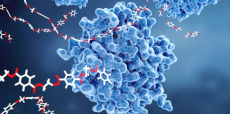

Biology Revision Sheet
The Test for Starch
Put a few drops of an iodine solution onto the food, if the iodine turns dark blue/black starch is present.
The Test for Glucose
Mash a piece of your sample food with a pestle and mortar. Mix the sample with 2cm of distilled water. Add 10 drops of Benedict’s reagent to the solution. Heat the solution in a water bath for 5min, remembering to put the lid on the water bath. If glucose is present the solution will turn from clear blue to green/yellow/orange/red.
Finding the energy content of food
To work out the energy content of foods burn the food over a test tube of water with a thermometer in. The formula is Temperature rise (of the water) x water mass (g) x 4.2(J per oC) divided by the food mass (g)
Enzymes
Factors which affect enzymes are: the pH and the temperature. Different enzymes have different optimum pH’s e.g pepsin (in stomach) prefers acidic pH’s whereas salivary amylase prefers a more neutral pH. If the temperature is too high (40+) then the enzyme becomes denatured and its active site changes shape.
Carbohydrates are broken down into glucose molecules
Lipids (fats) are broken down into glycerol and fatty acids.
Proteins are broken down into amino acids. Amino acids are made up of carbon, hydrogen, oxygen and nitrogen.
Enzymes are proteins and so are made up of 100-1000 amino acids folded up into a unique 3D shape. Different shapes have different functions. An enzyme is a catalyst and so increases the rate of reaction by making the reaction need much less activation energy.
Enzymes break down the food using the lock and key model. The substrate fits into the enzymes active site. A reaction takes place and the food molecule is broken down into smaller soluble molecules.
Balanced meals
For your body to work properly your diet must include: carbohydrates, lipids, proteins, minerals, vitamins, water and fibre. The amount of energy you need each day depends on: the amount of exercise you do; how big (weight/height) you are; your age (whether or not you are growing); and gender.
Different types of food and how they help you
Carbohydrates- they are the main fuel for supplying the cells with energy. The energy is released by oxidising glucose in respiration.
Lipids – make up 10% of our body mass, long-term store of energy.
Proteins- make up 18% of our body mass, needed for growth and repair.
Minerals – does essential jobs. Calcium= making teeth and bones. Iron = part of haemoglobin in red blood cells, gives blood its red colour and helps carry oxygen. Mineral deficiency can cause diseases.
Vitamins – vitamin deficiency causes serious diseases. Vitamin A = making a chemical in the retina and protecting the surface of the eye, Vitamin C = sticks together cells lining surfaces like the mouth. Vitamin D = helps bones absorb calcium and phosphate.
Fibre- helps keep digestive system clean and healthy.
image- https://www.labiotech.eu/industrial/carbios-bioplastics-recycling/

0 Comment:
Be the first one to comment on this article.